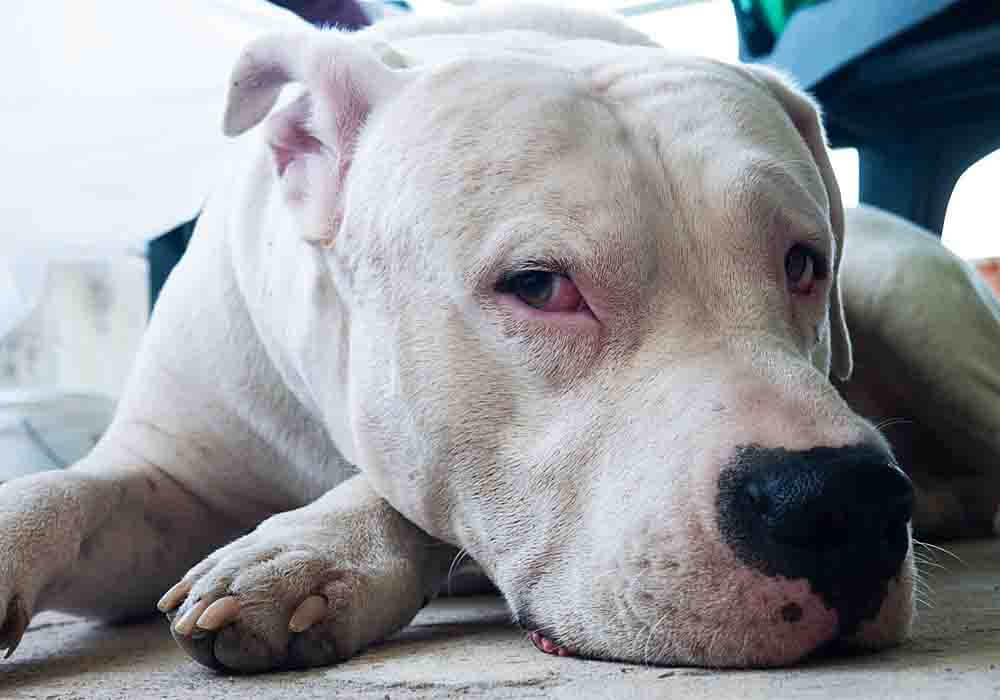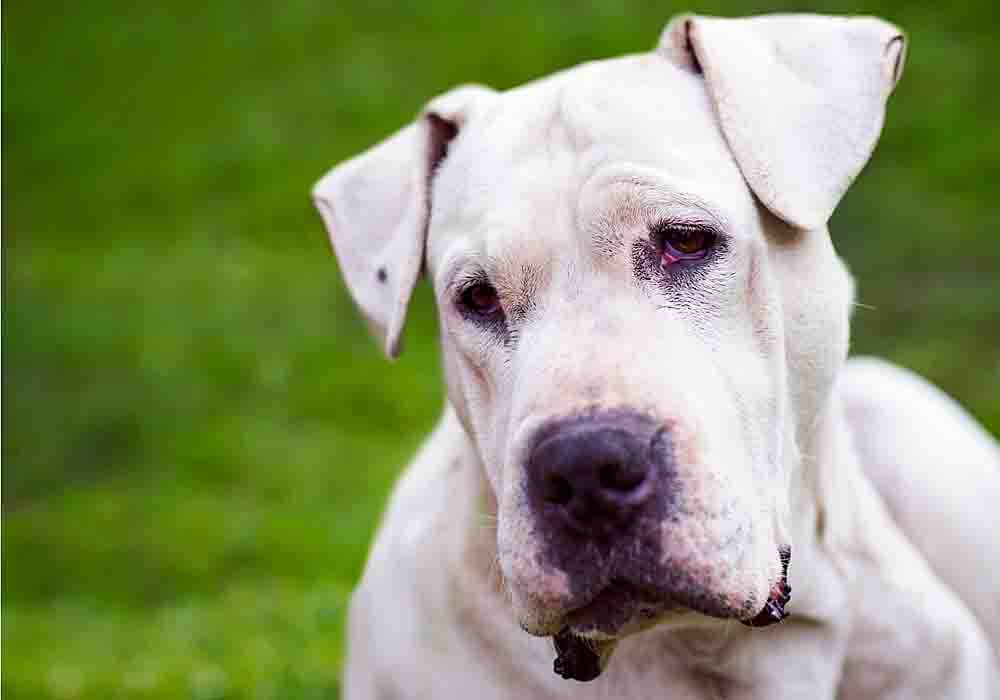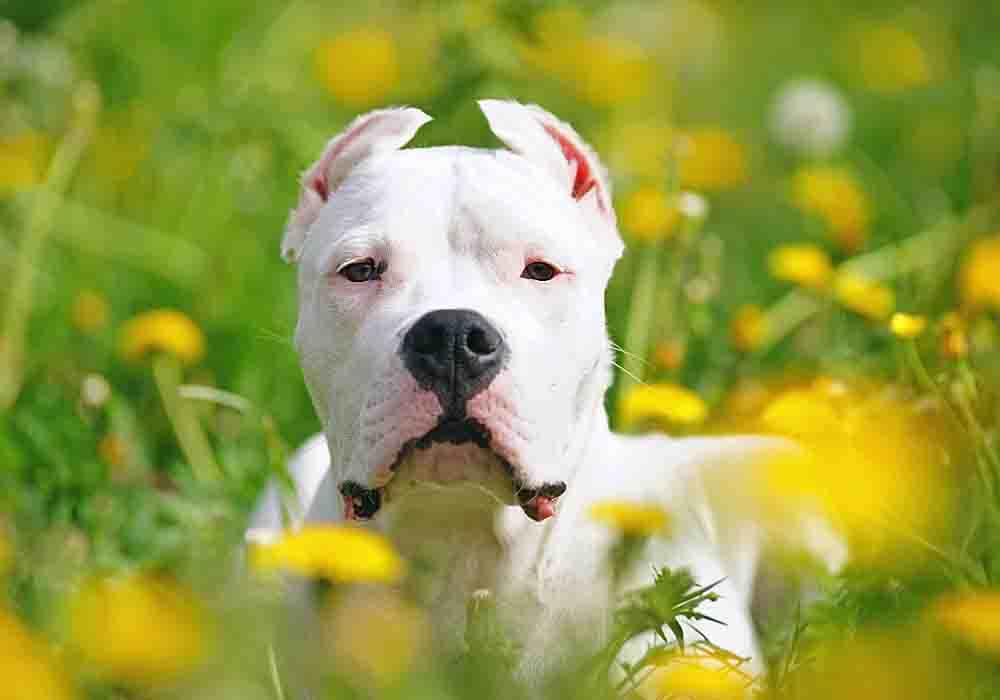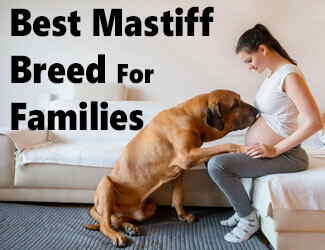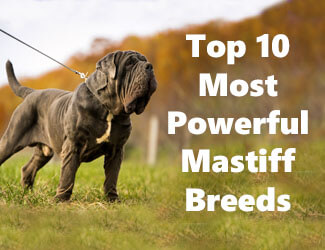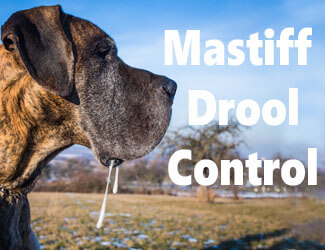Dogo Argentino Dog Breed
Information
by Ken Alden
History, Traits & Temperament
Dogo Argentinos, also known as Argentine Dogos
and Argentinian Mastiffs, is a breed of large-sized dogs. Their sheer strength
and size are really fascinating and can make potential owners quite curious
about their nature. Learning about their history, traits, and temperament can
help people decide whether they should adopt it or not.
So, what is the history of this breed, and what kind of traits and temperament do they have? Dogo Argentino was created in the early 20th century by crossbreeding various large-sized breeds. These dogs were originally used for fighting, but are now staple hunting and guard dogs. They are very brave, agile, strong, and smart, and are also very territorial and protective of their owners.
In this article, we’re going to discuss in detail the history of this breed and what their nature is like, along with their size and weight, and their price. We’re also going to talk about some health issues they might face, plus a proper guide to their care, training, and diet.
So let’s learn some things about this
wonderful dog breed, starting with its origin...
Pro-tip: Ever try lifting a Dogo Argentino? Their weight can hurt not only your back but their joints when they hop down from cars, sofas or even your bed. To protect your back and theirs check out the best Mastiff ramps on Amazon.com now.
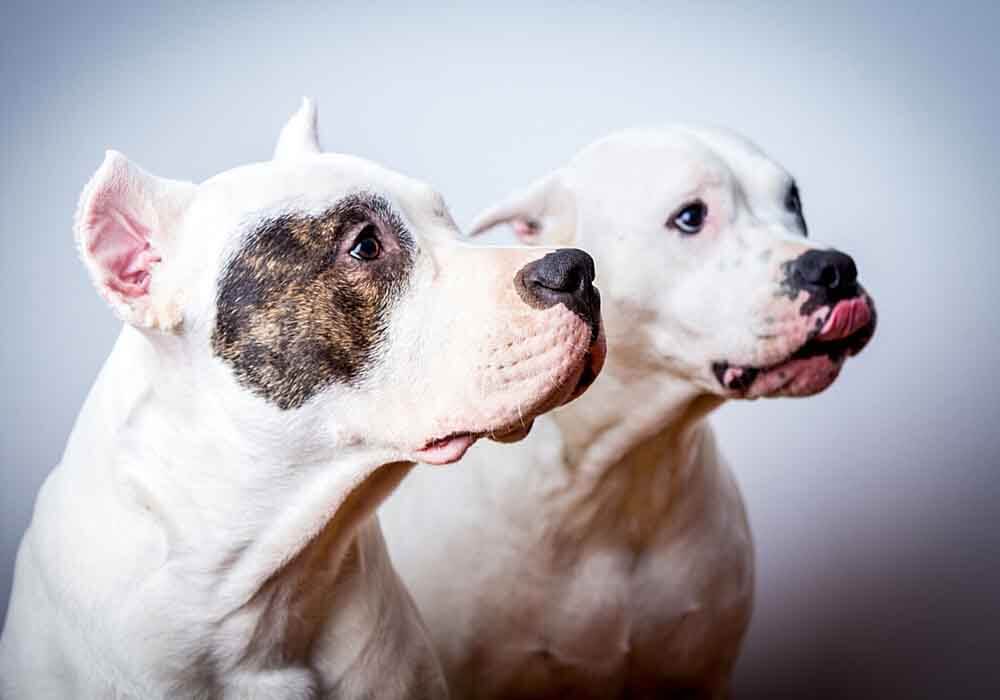
Dogo Argentino History
This breed of large-sized dogs originates from the province of Cordoba, which is a part of the Centre Region of Argentina. The breed was created by Dr. Antonio Nores Martinez. He was a renowned doctor who belonged to a traditional, dog-loving family. His passion for dogs led him to set the basis of a new breed in 1928. He named this breed Dogo Argentino and also set a standard for dogs to meet to be considered purebred.
Dr. Nores achieved this remarkable feat by different methods of crossbreeding among several purebred species like Great Dane, Bull Terrier, Pointer, Bullmastiff, Spanish Mastiff, Bull Dog, Irish Wolfhound and Great Pyrenees with the now-extinct Cordoba Fighting Dog. After doing years of character study, choosing the right breeds, and crossbreeding many dogs, Dr. Nores finally obtained his first family of Dogos.
Argentine Dogos were originally supposed to be fighting dogs, but Dr. Nores took his dog out hunting with him a few times, and the dog showcased fantastic skills. Thanks to its brave nature, territorial instincts, and agile reflexes, the dog became a big-game hunter. However, with the passage of time, hunting became obsolete, so the dogs adjusted to these changes, focusing their prey drives in a new direction: protection of their owners.
Now, they are insurmountable protectors of their families. They are very noble and are great companions to their owners. For over a hundred years, the dogs have been used to guard farms and houses against breaking in of small animals like raccoons to wild predators like pumas. The dogs were also taken along by hikers on long trips as they had the stamina and bravery to face mountain lions.
Thanks to the efforts of Dr. Augustin Nores
Martinez, the brother of this breeds creator, the breed was finally
recognized by FCI in 1973 as the first Argentinian breed.
Helpful Link: Read up further about this breed on the American Kennel Club website
Dogo Argentino Temperament
Friendliness
Dogos are moderately friendly dogs. They are quite friendly with their owners but aren’t too clingy. The dogs behave well around children but aren’t too friendly with them, so make sure to introduce the dog to children yourself, so they know how to behave around them. This breed is also friendly with elders.
Unfortunately, these dogs aren’t suitable for houses with other pets. They aren’t friendly with cats, dogs, rabbits, or any other animals due to their dominant nature. They do best when they’re the only pet around.
However, this doesn’t mean that they can’t be good guard dogs. You can keep one to take care of the chicken coop or barn animals. Their behavior towards birds and farm animals depends upon their training.
Speaking of guarding, since they have been trained to fight and protect their owners, they’re never friendly
towards complete strangers.
Intelligence
Argentine Dogos are very intelligent. They can memorize and understand new commands and tricks in just 15-25 repetitions. Their observance skills are amazing. Potty training an argentine puppy should take about a week.
Not only do they have great brain power, but
their senses also make them highly intelligent. Their sense of smell is
well-developed. They have a sharp sense of hearing. They can warn their owners
about trespassers based on their hearing alone.
Playfulness
Argentine Dogos are large dogs who need plenty of activity every day in order to maintain a healthy lifestyle. They need walks every day, along with an hour or more of playtime.
This breed is also moderately playful. They
like playing with their owners and by themselves, but they aren’t always
excited about games. Instead, they play for enough time a day that their quota
for daily physical activity is complete. These dogs like to play games like
fetch. Those that are trained to play with toys as puppies are much
more playful.
Emotional Sensitivity
This breed has a normal emotional level. They’re not very sensitive as compared to other dog breeds. They can form a routine, but they aren’t bothered too much if it’s changed. They can handle punishments quite well and don’t crumble apart when scolded.
This dog also has average affection towards their owners. They are friendly and protective but not to the point where they can’t sit without having their owners in their line of sight.
They don’t need too much social interaction as
well. They like being around their family but don’t mind being alone for a
couple of hours. This behavioral trait makes them suitable for working people.
Pro-tip: Dogo Argentino anxiety, aggression, destructive chewing, jumping up, fearfulness, and other behaviors can be controlled with the right training program.
Here’s a great course that
addresses these issues along with many other dog training basics: Check it out now!
Natural Behavior
This dog is known to be a particularly brave
species. They have a prey drive meaning they’ll try to catch birds and
squirrels on walks, so keep them leashed. They are very agile, so controlling
them can be hard without a proper leash. The dogs are mostly silent and stern,
so they should be trained that way.
Dogo Argentino Characteristics
They’re Silent
Dogo Argentinos are silent dogs. They only
bark if they spot an intruder on the property or want to grab your attention.
They also bark when they’re sick or anxious.
Strong
Since they were bred for fighting and hunting,
Argentine Dogos are very strong. They have superb physical strength that lets
them pull carts and sleds. Their bite force is 500psi, which is twice more than
a puma.
Smart
This breed is very smart and can learn most
commands in 15-25 repetitions. They understand their surroundings and remember
their way back home if taught.
Vigilant
This breed has a very sharp sense of hearing, so this dog is naturally very vigilant. It can alarm its owner if there’s a safety risk almost instantly. As guard dogs, they’re very observant.
Energetic
Argentine Dogos are very energetic. They are
active throughout the day, and you’ll find them running around in the garden
plenty of times. They don’t mind walking for an hour or more. These dogs sleep
for a small portion of the day.
Territorial
They are very protective of their owners and
their property. They wouldn’t hesitate to attack an intruder one bit. They are
excellent guard dogs and easily take care of unwanted animals and people alike.
Prey Driven
This dog is known to have a high prey drive. They
will chase after squirrels, raccoons, and other animals. That’s why they should
be leashed outside at all times. They also like to wander around on their own.
Adaptable to Changes
Argentine Dogos don’t mind changes in their
routine. You can occasionally play with them at a different time or set their
bed somewhere else, and they wouldn’t mind. These dogs don’t mind if you’re
moving house or taking them to a place of temporary stay, given that there’s
enough space. The dogs are also adaptable to changes in weather, though they
prefer a warm climate more.
Suitable for Houses
They are suitable for houses. They
are not suitable for life in apartments. They need plenty of space to live in.
Having a backyard or garden is very important, something only houses have.
Non-Hypoallergenic
These dogs are not hypoallergenic, meaning
they can cause an allergic reaction in people who are prone to getting sick
from common allergens. Such people might be allergic to this dog’s saliva or
dander (skin flakes).
Dogo Argentino Health Issues
Like most other large dog breeds, this dog suffers from health issues quite frequently. Regular checkups with the vet should be scheduled once a month. If you observe any behavioral changes, excess barking, swelling, wounds, itching, or other visible signs of illness, take your dog immediately to the vet.
Some common health issues you’ll find among these dogs include:
- Allergies to common things like dust, cold weather, etc.
- Diabetes.
- Obesity due to excessive eating or lack of physical activity.
- Bone Cancer.
- Deafness, either by birth or aging. These dogs are likely to develop some form of deafness quicker than other breeds.
- Hypothyroidism, a condition in which the thyroid gland produces fewer hormones leading to a slow metabolism.
- Hip Dysplasia, better known as the dislocation of the hip joint. This can occur due to a lack of vitamin C, vitamin D, glucosamine (a protein-sugar compound), or calcium.
- Elbow Dysplasia or dislocation of the elbow
joint.
Dogo Argentino Size And Weight
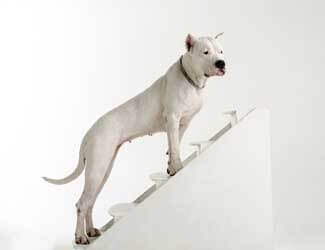
Dogos are large-sized species. Male Argentine Dogos have a height ranging from 24 to 27 inches or 61 to 68.5 centimeters. The average height of a male is 25.5 inches or 65 centimeters. Female Argentine Dogos have a height ranging from 23 to 25 inches or 58 to 63.5 centimeters. The average height of a female is 24 inches or 61 centimeters.
On average, male Argentine Dogos weigh 93.5 pounds or 42.5 kilograms while female Argentine Dogos weigh much less, having a weight of 74 pounds or 33.5 kilograms. A healthy male shouldn’t weigh less than 88 pounds or 40 kilograms or more than 100 pounds or 45.3 kilograms. On the other hand, a healthy female should weigh anywhere between 71 to 78 pounds or 32 to 35.4 kilograms, no more no less.
How Much Does A Dogo Argentino Cost?
The cost of this dog depends upon what you’re looking for. If you’re planning to buy an Argentine Dogo puppy as a family pet, the price is going to be very reasonable. Dogs that don’t belong to a superior bloodline and are bought from regular farms, sellers, or from their previous owners cost anywhere between $500-900.
If you want to buy one trained for hunting or guarding your house and farm animals, then it would cost you around $1500-3000. These dogs will be young and healthy and will have a muscular build. The price is basically the cost of their training. You can get in touch with various dog training institutes and farms to buy one.
If you’re looking for one for
breeding purposes, then these will cost you the most. Breeding dogs have a pure
bloodline and are registered with American Kennel Club. They can be bought from
registered and reputable breeding farms. Their prices start from $2000 and can
rise to as much as $7500 depending upon the farm.
Helpful Link: Learn further about how much one of these dogs cost as well as where you might be able to find one for purchase on the Petpricelist.com website
Pro-tip: Dogo's (and their owners) love dog crates…and for good reasons. Crates keep dogs from mischief while you're away, are perfect for house training, for traveling by car, and provide the dog a place to de-stress. Check out the best Mastiff crates on Amazon.com now.
Dogo Argentino Care
Coat Care
This dog has a short main coat and lack any undercoats. It’s easy to take care of their coats in comparison to other breeds. Haircutting is rarely ever needed. Brushing must be done at least twice a week to reduce shedding and hair damage. Brushing also removes dead hair and skin along with dust, and also evenly spreads the body’s natural oils; plus, all dogs love being brushed and groomed.
This dog is prone to sunburn as they have a
short coat and can get quite chilly in subzero temperatures, so make sure to
protect them and their coat from the weather.
Eye and Ear Care
Your Dogo’s eyes need to be cleaned regularly to avoid infection. Letting the rheum collect for several days can lead to infections that can cause further health complications. It’s better to clean their eyes every now and then than risking an emergency trip to the vet.
Similarly, the ears also need to be cleaned as
build-up can lead to infection. The ears of these dogs are naturally cropped,
so waste can build up quite easily. You can clean both the eyes and ears of
your dog using baby wipes or cotton balls. A regular pattern of cleaning (at
least once per 5 days) should be adopted.
Nail Trimming
This dog has faster nail growth than most other dogs. Their nails can grow very long if not trimmed for a while. Long nails are at risk of being broken, which causes immense pain. Sharp nails also get stuck in cloth and furniture. Nail trimming is a must once every two weeks.
Bathing
This is the part where you get a huge advantage over owners of other dog breeds. Dogos love water, so they naturally wouldn’t mind sitting in the bath for a while. Of course, you have to train them to like water from the start, but even untrained dogs are comfortable with the idea of getting wet.
There isn’t supposed to be a specific time for bathing, and it really depends on your dog’s routine. If the pup plays outdoors all-day long, it’ll need a shower more frequently than the one who stays inside more. Guard dogs need to shower every 2-3 months as they are outside a lot. The main reason for bathing your dog should be dirtiness or smell, but you can bathe them if guests are coming over or they have to go somewhere.
Bathing Dogos is very easy. You just need a dog shampoo (we highly recommend the Earthbath shampoo) for the coat, a sponge for scrubbing, some cotton balls for cleaning the face, and a towel for drying. You can bathe puppies in the sink and bigger dogs in your bathtub.
Teeth Brushing
Brushing the teeth of your dog is really important to prevent oral diseases. Signs of oral diseases include dark yellow/brownish deposits along the gum line, bleeding gums, constant bad breath, loose teeth, and swollen gums. If you notice any of these signs, take your dog to a vet.
To save yourself from a trip to the vet, make a habit of brushing your dog’s teeth. If you’re adopting a puppy, it’s a great idea to train your dog to not be afraid of teeth brushing. This will really help you once the dog’s older.
You should brush your dog’s teeth very gently. Make circular motions to cover every spot. Keep the brushing session short, not going over 3 minutes. Use a pet toothbrush (regular toothbrushes work fine in a pinch) and dog toothpaste. Always avoid human toothpaste as it’s corrosive and can cause dental issues. Giving your dog dental chews also helps maintain dental hygiene.
Bedding
Dogo Argentinos are usually outdoors for the most part of the day. Guard Dogos are usually kept outside while family pets are allowed inside.
If you have a guard dog, build a small doghouse for it, where it can rest. This dog can get sunburned during hot days, so you should either bring them inside or give them space in their doghouse to seek shelter. Make sure to give them water. Never put a chain on your pooch. If the weather gets very close to the freezing point, bring your dog inside.
As for bedding, They really don’t need much. A
plain blanket works just fine. Buy one that is easy for you to wash. You can
get a dog pillow if you want. You can set up their bed on a soft rug in your
bedroom or the living room.
Learn more about the best beds for Dogos on this page of our site...
Basic Supplies You'll Need
There are a couple of basic supplies you must buy for your pal, starting with a food bowl and a water dish (preferably stainless steel). You’ll also need a leash for walking your dog and a collar to attach the leash to. If you have a puppy, buying a crate is a good idea. You can leave your little pup in the crate for its safety while you’re running errands.
Next, you need to buy some grooming supplies. These include:
- A brush or a comb for regular brushing.
- Nail clippers.
- Nail grinders (optional).
- Dog shampoo.
- Anti-flea spray.
- Dog toothpaste.
- Some towels, cotton balls, and bath sponges.
Toys
This dog is a very active breed. They need to exercise a lot and are naturally very playful. Daily walks aren’t enough on their own. Buying a couple of toys for your dog is a great idea and will help them burn energy. Dogs that are trained to play with toys as puppies are more likely to respond with an urge to play on seeing a toy.
Now, you’ll have to choose the kind of toy
your pup should play with carefully. This dog has a very strong jaw
that can rip apart some toys. Pieces of these toys can get stuck in their
throat. Avoid giving rawhide toys to your dog. Simple toys like balls, discs,
and ropes are safe options.
Dogo Argentino Training
Argentine Dogos are very loyal to their owners and are often surprisingly easy-going, making them easy to train, especially if you don’t have much experience. They have a dominant nature; hence a dominant owner is the most ideal.
Most of the essential training, such as behaving around children, less barking, playing, potty training, and food etiquette, need to be taught before the dog turns six months old. It becomes tough after it. You also have to teach your dog to sit calmly when it’s being bathed or groomed as a puppy.
Never scold the dog unless you’ve caught it in the act; otherwise, the dog will feel guilt but won’t know why it was being scolded in the first place. Locking the dog in an isolated room as punishment is not an option.
Training your dog basic commands takes 20 repetitions on average. Give your dog a treat after it has followed a command. Be stern with your commands.
For potty training, designate a mat or an area
in your lawn where it can go defecate and always take your dog there. For
puppies who are yet to learn, take the dog to defecate once in the morning,
once late at night, and after each meal. Training the dog to walk with a leash
is also very important. You can do this in your garden.
Best Dog Food For Dogo Argentino
The diet of this dog needs to be based on plenty of proteins and carbohydrates, along with an adequate amount of vitamins, minerals, and fats to make sure they sustain a healthy lifestyle. These nutrients can be provided by giving your dog high-quality dry food from a premium brand.
There’s different food for puppies and adults. Dogs up to the age of 9 months should be fed puppy formula. After that, adult formulas should be gradually introduced. By the 12th month, your dog’s diet should be adult dog food only. Puppies need to be fed three small portions each day, while adults should be fed two large portions.
Here’s a couple of our favorite dog foods on Amazon.com
Taste of the Wild High Protein Premium Dry Dog Food
This premium dry food contains grains like chia, millet, quinoa, and sorghum, which contain plenty of fiber and protein that strengthen the muscles of your dog while also being easy to digest. It doesn’t contain any fillers like wheat or corn and is also free from preservatives. Roasted bison and venison provide it great flavor.
Purina Puppy Chow Natural With Farm-Raised Chicken Dry Puppy Food
This dry food is perfect for growing puppies as it’s rich in DHA, vitamins, and minerals. It contains chicken and beef for protein and is free from any unnatural preservatives. You can feed this to your puppy for its 1st year.
Taste of the Wild Grain Free High Protein Premium Dry Dog Food
This grain-free dry food contains venison,
which makes it full of proteins that help build and strengthen your dog’s
muscles. It also contains vitamins, antioxidants, probiotics, and minerals that
provide proper nourishment for eyes, coat, bones, and help keep the digestive
tract healthy. It’s free from artificial preservatives and additives.
Read our enlightening reviews of the best dog foods for Mastiffs here...
Conclusion…
The Dogo Argentino is a large breed of fierce, courageous, and clever dogs. They are very protective of their owners and are quite territorial. They love their owners even if they remain silent and don’t show it.
These dogs are suitable for adults who can
give them serious commands. They thrive in spacious houses without
any other pets around. They need minimal grooming and regular vet checkups. If
trained well, this breed makes for one of the best pets.

About the Author...
Ken Alden, a dedicated Mastiff owner for over eight years, is acclaimed for his expertise in care, grooming, and training. Read more About Me and my dog Shadow.
- Mastiff Guide Home ›
- Dogo Argentinos Dog Info ›
- Dogo Argentino
